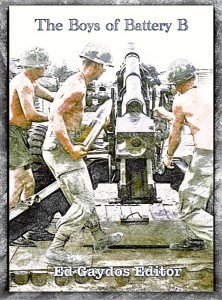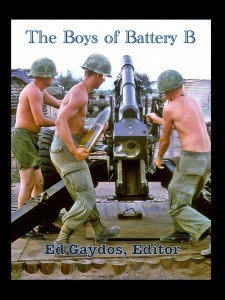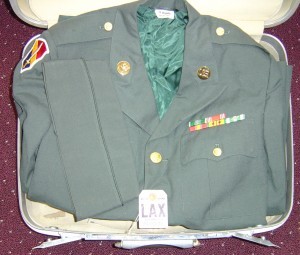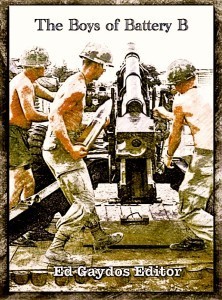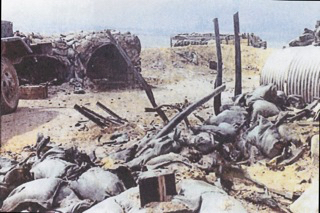Ed Gaydos's Blog, page 10
June 10, 2015
Bill Cooper – B Battery XO (Executive Officer) – Part One
I was looking forward to getting out of this dead end town. (Danville, Illinois). I just wanted to get out into the world. I had been sleeping on a couch at my grandma’s for the past few months because my stepfather had thrown me out of his house. So I dropped out of high school in the middle of my sophomore year to enlist in the Army. I turned 17 on September 19, 1959 and five days later I am on a train to Chicago to the Army induction center. I have a shaving kit, five dollars and the clothes on my back.
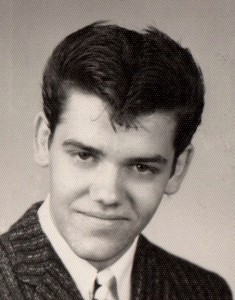 Just before enlisting
Just before enlisting
I arrived late in the afternoon and was met by a soldier who walked me and the other guys to a hotel a couple blocks away, where we were paired up in rooms. Then we walked to the Army induction center for our physicals. A large room was laid out in stations; you turned your head and coughed and moved on. We broke for chow and returned for more stations. It was very late when we returned to our hotel.
Some guys said, Let’s go see the town. I went along and one of the older guys got us beers. We got to talking and one of the guys said once you get in the Army your body is government property. Let’s get our tattoos now because if we do it later we would be defacing government property. What did I know? When I returned to the hotel I was two dollars poorer and had a tattoo on my right shoulder, a heart with a wreath around it.
This wasn’t my first tattoo. When I was 15 my uncle came back from the Marines and of course he had a couple tattoos. I watched him put a tattoo on my older brother with a sewing needle stuck in a wood matchstick and stovepipe soot. I thought, Wow that’s cool. I got ahold of some India ink and put a needle in the end of a matchstick like I saw my uncle did, and I tatoo’d on my left forearm BC for Bill Cooper. Twenty years later when I was a battery commander a sergeant looked at me and said, “Sir, you’re really serious about this job aren’t you?”
I said, “That BC’s been there a long time.”
Basic
From Chicago we loaded on buses for basic training at Fort Leonard Wood in Missouri. By now I am broke, the five dollars long gone. After unloading into a barracks I found the mess hall and had a great Army meal.
The next morning we began three days of processing. Each morning we had to fall out and line up at one of three colored stakes. Red was for the first day, blue for the second day and white for the third and final day of processing. The first day we got our uniforms. I learned that the Army had just changed uniforms. The dress uniform went from brown to green, and footgear went from brown to black.
In 1954 the Army decided to make changes to the uniform, in part so that officers and enlisted uniforms should be the same, distinguished only by insignia. But it was not until late 1957 that the new uniform was issued to inductees, with a transition period of four years to allow wear-out of existing uniforms. Bill landed in the middle of this transition period when the Army was still issuing both colors of footwear.
When I went through the initial round of getting my boots they were issuing brown boots with a bottle of black dye. If you got the brown boots and brown low quarters you had to dye them black, which was a mess, and you had to keep doing it. One of the old timers said to me, “If they bring you a pair of brown boots tell them they don’t fit until you get the black ones.” Sure enough they brought me a pair of brown boots. They fit perfectly but I said they were too tight. They went and got me a different size, but they were black and I said these fit perfectly. The poor guys stuck with brown shoes had black fingers forever.
One the third day – after a day of trying to march, getting our hair cut, and receiving a five dollar advance on our pay – we were on our white stakes and told to board a bus for new barracks and the beginning of our basic training. The barracks sergeant told us this was his house, which we had to treat well, and he taught us how to make a military bed. We had maybe a hundred guys, fifty upstairs and fifty downstairs.
Then we met our drill sergeant. He was a whole new kind of person. I never met anyone who could yell so loud, and he seemed to yell every word he spoke. He let us know we were stupid civilians and to forget all that we had learned till now. He was going to tell us all we needed to know from here out. There was the Army way and the wrong way, and we would damn sure learn the Army way.
I learned that the Army was everything I had expected and hoped for. I was quick to learn the rules and what was expected of me, and it was the same for everyone without favorites. We were given tests to see what we were good at or at least what we had a little knowledge of. I knew a little about cars and how they run, because I had an old clunker that I had to keep running the best I could. I loved to drive. The Army found that I was interested in this field and took a chance on me. I was to go to LVDC school after basic (light vehicles up to 2 ½ ton trucks).
Right after graduation I had a few days off. I returned to Danville to see Grandma and Mom. I met with some of my old friends and I talked with them about what I had been doing. They seemed so childish to me now. I had moved on with my life and no longer fit there. I could not wait to get back to the Army base. It just felt like home to me and I was beginning to give some thought to staying forever.
Right out of training I got orders for a light truck company in Germany. I flew to New Jersey to board the USS Randle. Early in the morning there were 1700 troops getting aboard. I had never seen so many people in one spot in my life. They put a chalk number on your helmet and herded us like cattle into stalls in these big hanger type buildings.
I met a guy who was a private like me but older. He had been in the Army, become a sergeant, gotten out and then come back in the Army again. But he had stayed out too long to come back with his old sergeant rank. He was in his late twenties and an old guy to me just 17, and a streetwise fellow. We kind of connected.
This guy heard that the Red Cross was giving out donuts and coffee and we should go get some. No, I said, we were told to stay right here so that when they call our packet number we get on the ship. He said, Screw that, we got time. We found the Red Cross, got our coffee and donuts, and slowly worked our way back to the hangar. When we got back to our stall we found it empty except for our two duffle bags leaning against the wall.
We got on the bus that was taking guys down to the dock and worked our way into the formation. It was still dark out it was so early. He said, “Now they are going to pick details as people get on the boat so we don’t want to get on too quick.” As the front ranks moved onto the boat we kept falling back. We were in the last rank getting onto the ship and the fellow checking off names had to go back through the book about ten pages to find our names. The good news was that all the details had been picked: guard duty, KP, whatever.
On our way to the bunking area he snatched a couple paper tags and wrote PAINT SHOP on them, and we tied them to our field jackets. The next morning we got up early with everyone else, went topside and laid on these huge coils of rope at the rear of the ship. We goofed off all day, and if anyone asked we were on break from the paint shop.
Things went well for three days. On the fourth a Navy-type sergeant (called petty officers in the Navy) walked by and asked what we were up to. We told him we were on break from the paint shop. He said to get back there. As we started to walk away he said, “Where are you going? The paint shop is in the other direction. I’ll show you the way.” He took us way down to the bottom of the ship to a sergeant who said he had never seen us before but he could keep us busy the rest of the trip. So for the next three days we chipped paint and spot painted all over that ship.
June 5, 2015
John Clay – Gun Crew – Part Three
I extended my tour in Vietnam by two months so that when I went home I could get an early out from the military. (Soldiers returning from Vietnam were given an “early out” if they had less than five months remaining.)
When I left I brought a mortar fin and two 105 canisters that I had made into vases. There was a place in Phan Thiet where they would put the canisters into a kind of press, and make them into vases. One of them says 1945 on the bottom. We were still shooting ammo left over from WWII and the Korean War. Yeah, they had dates stamped on the bottom.
Back in the rear I got a brand new set of fatigues, a brand new pair of boots and a brand new field jacket. I was all set to go. When they called my name and number I wanted the hell out of there so bad I left all that new stuff on the bunk. Whoosh I was out of there. Guys got killed in the rear area coming out of the PX. That happened. You could die anywhere.
Home
At Ft. Lewis, Washington I processed for two or three days, which involved this re-up talk and that re-up talk, then flew to Los Angeles where my parents picked me up. At home I was so wound up all I could do was talk for about 18 hours. Then one night I was having dinner with my Mom, and the next thing I remember I woke up a day and a half later. I guess I fell asleep with my face in the mashed potatoes and my Dad took me to bed.
I thought I had a suntan, until I had a few warm showers and it all just washed down the drain.
Half of ’69 and almost all of ’70 are blank to me as far as what happened back home. I missed the moon landing and all kinds of stuff.
Poet of B Battery
I started writing poetry about my time in the Army; it helped to sooth my mind. Three years ago I was rummaging through some stuff and found one of my handwritten poems I thought I had thrown away.
It’s called The Fire Mission about a three-hour shoot on August 30, 1970. I remember the date because I kept a calendar where I circled the dates we got mortared and put in notes of other things that happened. In February for example I circled the mortar dates 4, 9, 10, 11, 19, and 26.
My calendar has a note we got 20 kills on that August fire mission. The poem is how I felt at the time about the mission and death.
After shooting a fire mission the troops waited for an enemy body count from the forward observer on the ground or the air observer overhead. John’s poem captures the mixed feelings of boys living every day with death, the enemy’s and maybe their own.
The Fire Mission
Death is far, yet seems so near
The gun is silent the smoke is clear
The rounds are spent our mission done
One by one we leave the gun
We sit and wait, the battle won
The radio is silent, no word has come
In the field the bodies lay
Never to fight another day
We’ve won again, but there is no cheer
Death is far, yet seems so near
A Memory Box
When I flew home from Vietnam I got to the Los Angeles airport before my parents arrived. I went into the restroom and took off my uniform because nobody thought much of it back then. I got into my civvies and put the uniform in my suitcase.
I still have that uniform in the same suitcase I brought it home in with the airline hangtag still on it.
The uniform has a few moth holes in it, but it’s there: the pants, the jacket with my medals pinned on it and the dress cap. I’ll never put anything else in that suitcase. I open it and look at my uniform every once in a while. I am happy I served and I can open up that suitcase like a memory box.
May 27, 2015
John Clay – Gun Crew – Part Two
I Don’t Remember Hardly Any Names
… because most of the time nobody wore a shirt with your name on it and we used nicknames so much. My nickname was Cassius, for Cassius Clay. A guy from Missouri everybody called Old Red because he was older and he had red hair. There was a really tall black guy we called Slim. I have more nicknames in my head than real names.
My gun sergeant was this big huge guy, must have been 300 pounds and 6’3 or 6’4 with blonde hair and a mustache. He was an old lifer E5 and champion beer drinker who had been busted more times than the average and then promoted back up again. (This character everyone called The Swede.)
Then Sgt. Rock came along as my gunnery sergeant, a shake and bake out of gunnery school. We called him Sgt. Rock from the comic books (character created by Robert Kanigher and Joe Kubert for DC comics first appeared in 1959).
There was a guy on Gun 1, a big farmer type everybody called Baby Huey (a giant duckling cartoon character created by Martin Taras for Paramount Pictures uttered its first quack in 1949.) I remember we were very good friends. He was the one who gave me the nickname Cassius.
I Do Remember …
… using powder from the extra powder bags to heat shower water. This was against procedure because we were supposed to take the bags out to the dump and burn them in a pile. An exception was using them to heat water for the officers, which was one of our duties. But we weren’t allowed to heat our own water.
… how we put warm beer in the LRRPs because the water wasn’t any good.
These were freeze dried food packets used on Long Range Reconnaissance Patrol missions, referred to as LRRPs and pronounced “lurps.”
… when Johnny Grant came to the firebase. He was an old master of ceremonies kind of guy they called The Honorary Mayor of Hollywood. He came out with a couple of Playboy bunnies and they did a show.
… helping build the bar that was our “club” in the middle of the battery. I was always handy with wood. I had a fancy hooch. I was one of the first people to take the blowtorch and burn the wood and make it look like walnut. It was amazing what you could do with a bunch of empty ammo boxes
… starting to smoke and drink in the Army. The Red Cross gave us the cigarettes in care packages. I gave up the smoking about ten years later. Also gave up the drinking because it bothered my stomach.
… when Davis got killed (Jeffrey Lynn Davis killed April 16 , 1970). He was a nice guy. I think he was on Gun 2, the gun as you came out of FDC on your right hand side. He was in the ammo bunker when a mortar round landed in the doorway. There was another guy who got a lot of shrapnel in his face, a little stocky guy. We all went over trying to do something for them, and then the Medevac arrived and off they went.
… when I first got to Sherry we just had the old WWII split tail howitzers. To swing them around you had to take a couple guys and physically pick up the trails. Then the M102s with the wheel on the back came in that you could just wheeled around in a full circle.
… Commo Daddy on mine sweeps down there with a knife probing when they found a mine. (Commo Daddy was a common nickname for the communications section chief.)
… one time I was on guard duty and saw a woman and her kids digging outside the wire where we had a bulldozer. I called it in and the First Sergeant went out there with a couple people and found a booby trap.
… vaguely early in my tour a guy got killed on a Duster when we got mortared one night, by the nickname of Chicken Man.
… stealing stuff when we’d go to the rear area: the metal runway material and heavy rubber tarps for building hooches, stuff you couldn’t get. I remember we stole some because they were just sitting there rotting in the sun.
… when Junk Daddy traded for that big generator is when I sent away for my four-track tape player and listened to Crosby, Stills & Nash at night. (Junk Daddy was the common term of affection for the supply sergeant.)
… one night during a mortar attack someone accidentally set off a green flare. That meant Viet Cong were inside the perimeter and everyone was shitting in their pants.
… that I avoided playing poker and stuff like that. I think I got that from my father. He said, “Beware of playing poker and guys you don’t know.” When we got paid I had a checkbook and when the paymaster came I could cash a check. That’s how I got money. All of my money went into an account. I never got my month’s pay in my hand.
… Paul Dunne. He was one of the first guys I really got to know. When I was stuck in FDC I’d go out at night when things were quiet and we would go get coffee and just walk around. Two months after I met him he’s dead, killed on a mine sweep going into town. My dad – he served in Patton’s Army in WWII in the Battle of the Bulge and had a piece of his skull blown out by a sniper – told me I might loose friends, and he was right. To this day I still think about Paul.
May 20, 2015
John Clay – Gun Crew – Part One
I dropped out of college and volunteered for the draft for personal reasons. I just wanted to get the hell away for a while. I went down to the draft board in February of ’69, got in line and when I reached the desk said I wanted to volunteer for the draft. The guys behind me in line looked at me like I was nuts. So they drafted me on Fools Day April 1. Three months later they came out with the lottery and gave me a very high number, which meant I never would have had to go to Vietnam. Still I am so glad I went, and so glad I did my time.
In basic training at Ft. Ord, California they offered me a spot in Officer Candidate School. To do that I had to re-up for an extra year, so I said, No thank you. I went to Ft. Sill for artillery, took a bunch of tests and they offered me the E5 school. I said, No thank you to that too.
I was trained at Ft. Sill as a cannon cocker, but when I got to Sherry they were looking for people to help out in Fire Direction Control because they did not have enough trained people. The First Sergeant asked if anybody had been to college. I remembered never volunteer for anything, but I went ahead and mistakenly raised my hand anyway. At first I had a good time there. I handled the radios for a while, communicating with the guys in the field and back at Phan Thiet, and then they had me plotting fire missions. My training was all OJT.
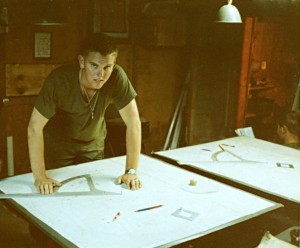
John in Fire Direction Control at the plotting tables
Note the two tables. During a live fire mission there was always a guy on a second chart figuring up the same data as a check. Before the firing commands could go to the howitzers every setting had to be called out from the primary chart and answered with a “CHECK” from the guy on the second chart.
Pretty soon I was bored to death in FDC because that is not what I was trained for. I kept asking, “When can I go out to the guns?” We worked 12 on and 12 off, and the only time I got to meet the guys on the guns was at night. I’d walk around and talk to them. I actually volunteered for a mine sweep into Phan Thiet, just to get the hell off the battery.
Finally after four months someone came into FDC who was trained and I went out to Gun 5. I think the name of Gun 5 was BOOM BOOM. One of the guys on the crew had been wounded five months prior when Gun 3 took a direct mortar hit. His chest was just a mass of scars.
I started out as an ammo humper, then worked the radios, and ended up being the gunner after a couple months. (The gunner and assistant gunner operated the howitzer during a fire mission.) You’re running around checking the fuses and getting the right settings on the gun. And you had to be quick. I think that’s why I was the gunner most of the time because I was quick at setting the gun up. I’ve always been able to learn stuff pretty fast. Probably why I started off in FDC.
Gun 5 was the battery base piece (the gun on which the battery was registered and therefore the most accurate of all the guns). Before I got to Sherry Gun 3 in the middle of the battery was base piece, but after it got hit they reconfigured the battery into a circle so every gun had a clear view for perimeter fire. That’s when they made Gun 5 base piece, and the spot where Gun 3 was stayed empty and became sort of holy ground.
On base piece we shot tons and tons of fire missions, because if you ever just needed one gun it would be us. On the gun you were just always there. A typical day was clean the gun, fill sandbags, cut powder charges, take the extra powder bags out to the trash dump, and burn them.
Every 105 mm round came with seven bags of powder numbered 1 through 7 and strung together with a cotton cord – a kind of artilleryman’s rosary. Setting a specific charge involved cutting loose the desired number of bags and loading them into the canister. The extra bags piled up and had to be disposed of, usually by burning them at the trash dump outside the wire.
Then you had guard duty at night. We did not have shifts like in FDC. We were always on. I can’t tell you how many times you were asleep and heard that thump from a mortar tube and you were up and out of your hooch as quick as you could. If you were already on guard duty you got to the gun and pulled the lanyard. There was a high explosive round with a short time fuse you always kept in the gun. It would explode out above the wire in case anyone was out there. You only had a few seconds before the mortar landed to get back under cover. You had time between the thump and when the mortar landed, but you had to be quick. That was typical stuff you did on a regular basis.
I’ve got tinnitus, ringing in my ears, from my time on the guns. The earplugs they gave you were those crappy little rubber things compared to the ones they have now days. And it was kind of hard to wear them because the radio operator sat in that little sandbag bunker and yelled the commands to the gun that came from FDC. If you had your earplugs in you could not hear them that well. I was constantly pulling them out and putting them in. Half the time I’d just hold my hands over my ears, which the assistance gunner could not do because he was pulling the lanyard. There’s a big difference between a charge one and a charge seven.
Imagine an ice pick in each ear and a baseball bat to the chest, that’s what standing next to a charge seven without ear protection felt like. Now imagine that 30 times in quick succession, ten times a week for year, and you begin to approach the ordinary life of a howitzer gun crew.
I never got to the rear very much. We’d go on convoys to Phan Thiet and then come right back again. Some guys got headquarters jobs up in Phan Rang but I never wanted to. For some reason I just liked being where I was.
May 13, 2015
Jim Scavio – Radar Section Chief – Part Four
Pictures That Tell A Story
 Montagnards were largely Christianized tribal people from Vietnam’s central highlands. They were true friends of American soldiers during the Vietnam War, and they paid a terrible price. More than 50 percent of adult Montagnard males were killed alongside American soldiers during the Vietnam War. This is a picture of Montagnard village between An Khe and Pleiku. Notice that there are only young people and women.
Montagnards were largely Christianized tribal people from Vietnam’s central highlands. They were true friends of American soldiers during the Vietnam War, and they paid a terrible price. More than 50 percent of adult Montagnard males were killed alongside American soldiers during the Vietnam War. This is a picture of Montagnard village between An Khe and Pleiku. Notice that there are only young people and women.
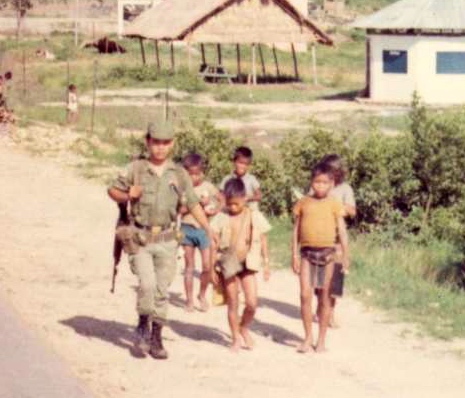 You couldn’t help but wonder what the future holds for the kids who watched their father go off to join his unit.
You couldn’t help but wonder what the future holds for the kids who watched their father go off to join his unit.
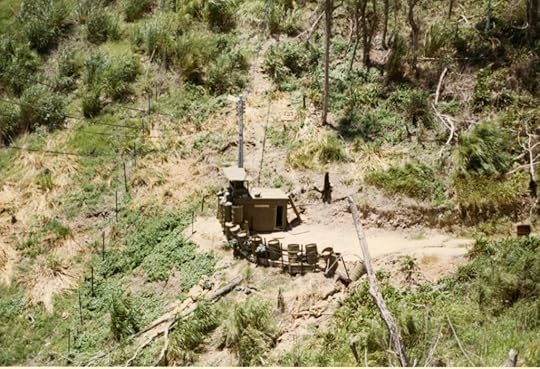 The whole area on either side of highway through An Khe pass was once double canopy jungle. When I first saw the landscape as an FNG ((funny new guy) I asked an old timer if they had bombed the area with B52s. He laughed and told me, “That’s Agent Orange”.
The whole area on either side of highway through An Khe pass was once double canopy jungle. When I first saw the landscape as an FNG ((funny new guy) I asked an old timer if they had bombed the area with B52s. He laughed and told me, “That’s Agent Orange”.
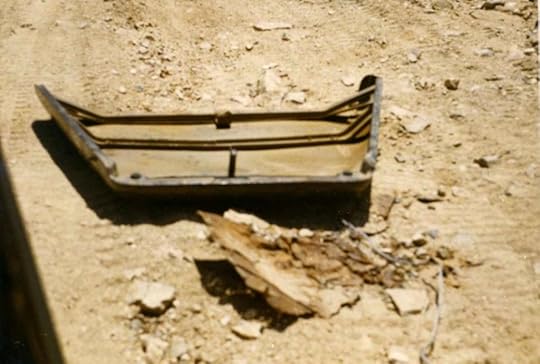 There were constant reminders that there were mines everywhere. If it was strong enough to blow the hood off, what happened to those who were riding inside? Notice all the tracks going around the hood, probably indicating another booby trap underneath it.
There were constant reminders that there were mines everywhere. If it was strong enough to blow the hood off, what happened to those who were riding inside? Notice all the tracks going around the hood, probably indicating another booby trap underneath it.
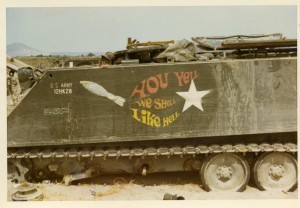
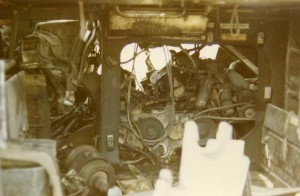 The Armored Cavalry had a bad day today. This mortar crew APC (Armored Personnel Carrier) hit a large mine made from an artillery shell while on patrol. None of the crew inside made it.
The Armored Cavalry had a bad day today. This mortar crew APC (Armored Personnel Carrier) hit a large mine made from an artillery shell while on patrol. None of the crew inside made it.
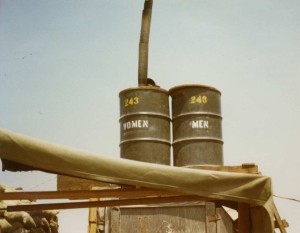 LZ Sherry had all the amenities. Here is our hot and cold running water system. Unfortunately we had to wait until the rainy season came before those barrels had water in them. Otherwise it was 110 degrees in the shade.
LZ Sherry had all the amenities. Here is our hot and cold running water system. Unfortunately we had to wait until the rainy season came before those barrels had water in them. Otherwise it was 110 degrees in the shade.
To see all of Jim’s pictures and commentary go to:
May 6, 2015
Jim Scavio – Radar Section Chief – Part Three
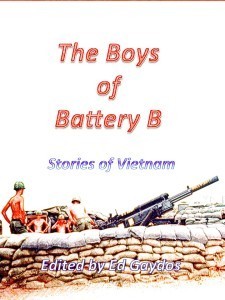 Leaving Vietnam Was Harder Than Going
Leaving Vietnam Was Harder Than Going
When you get short you think this is not the time to die. There was a guy on the quad-50 machine guns right behind my bunker who died the week he was supposed to go home. Those guys were always the first to shoot when we got hit, the first to get the action going. During mortar attacks this quad-50 was my alarm clock most of the time; when it went off it shook the ground. During a mortar attack he got hit with shrapnel that went underneath his helmet, hit him in the temple and killed him dead.
A few days before I was supposed to leave LZ Sherry for home, in early May of 1970 when LZ Betty got overrun, I was outside again – it was night but don’t know if I was in the can or not – and they started walking the mortars in on us. The explosions were coming closer and as I ran away from them I crashed into one of the bunker walls I didn’t see in the dark and broke my nose and busted my front teeth out. Still I did what I was supposed to do: I checked on my operators and then went to my fighting position and made sure we had guys out there. This one guy in his fighting position wouldn’t put his head up, so I had to go in there and rouse him up to start looking. I then went to my roof top observation post to look for mortar splashes, then came back down again and was running around through all the smoke and craziness.
I ended up getting sulfur burns on my face and hands too that night, which really hurt if you’ve ever had a sulfur burn. I don’t know how it happened, but it must have come from someone popping a smoke round somewhere and me not knowing I was right next to it. That was so much worse than my nose and teeth, because it really hurt. The next day – I’m really short by now – I talked to the medic and said my face and hands are burning. I’ve got this hole in my lip and my teeth are broken, but what I really want is something for this burn. He said, “I can’t do anything for you. They’ll take care of your teeth when you go home.” He told me not to get treated in country because I’d go to a hospital and be in the Army for another 30 days. I could not deal with that. I can tough this out. In three days the burns on my hands and face turned black.
I’d been on LZ Sherry for six months and I had not been paid for the last four. It was like they lost me. I never heard from my battalion anyway; those guys never left headquarters. (Jim’s chain of command stretched 300 miles north to An Khe where the 8th/26th Artillery – Target Acquisition – had its headquarters at Camp Radcliff.) I’d rarely see anyone from battalion in the field. The only time we’d see any brass on the firebase it seemed to me is when we took casualties. They’d come down and they’d be all over you for a few hours, quizzing you about this and that.
When I had about a week to go I learned battalion had sent a message down for me to go home 30 days before that, but by the time it had gone through six or seven hands it was so garbled nobody knew what it was. I would not have gone back anyway, because if I had to spend any time in the rear I would have been busted back to private. My replacement was there and he said I could go anytime I wanted, but I said I would stay till the last minute, and then hopefully I’d stay out of trouble when I went back there, because the rear areas at that time were beyond beyond. They were crazy places and I knew I would not fit in.
A part of my attitude about the rear came from a trip I made back to Camp Radcliff from Sherry with one of my guys who was going up before a promotion board. It’s a long way, a number of chopper rides to get back up there. We finally get there and we look awful, we’re dirty, we’re carrying our weapons and all our stuff with us down a road through the camp when this jeep goes by us maybe 50 feet when all of sudden we hear the screech of brakes. It goes in reverse back to us carrying a new-dude major. You can tell he’s a new-dude because his fatigues are brand new. We salute him and then he chews us out for not walking in step. This kid and I looked at each other and said, “Jesus Christ, what is the matter with these people?” We did everything we could not to draw on him. That’s why I was happy as a clam in the field. If they made me go back there for any length of time I would be in trouble. I had enough trouble as it was keeping my mouth shut.
I have all my stuff packed up and I’m ready to leave. They mounted the convoy to LZ Betty. We were not aware of everything that had gone on at LZ Betty, at least I wasn’t.
In the early morning hours of May 3, 1970 an NVA battalion of five companies in consort with five companies of VC, a force of 350, overran LZ Betty. They killed seven U.S. soldiers and wounded thirty-five, leaving behind fourteen bodies of their own they could not carry away.
All I remember is that the sun was beating down on me and that it was really hot on that convoy. My face was burning so bad that I jumped off and went over into a rice paddy and put mud on my face to cool it. When we finally got to Betty it was going to be awhile before my chopper would leave to take me to Phan Rang. I went over to the MASH unit to see if they had some sort of salve they could give me. The medic there looked me over and said, “We really don’t have anything that’s going to help you. We could admit you, but if we do you’re going to be here for awhile.”
I said, “I’m going home, man.” So I went to Phan Rang, was able to visit with my warrant officer friend who extended so many times, and found another chopper ride up to Camp Radcliff. I walked into the battalion headquarters, went into the top sergeant’s office to check in. He looked up and asked me what I was doing there. I said, “I’m going home.”
He said, “You went home a month ago.”
At which I erupted. I was so mad I went into a tirade, for them not to know where their people were. He was a good ol’ sergeant major and he let me vent on him, to the extent that I almost got out of line. He tried to explain, but I wasn’t having any of it. He finally told me to cool my jets before I ended up in jail. I said, “Just get me out of here as fast as you can.”
You know how you had to have a reenlistment talk. I think mine was the fastest there ever was. I said it was just not for me, and he said, “I’m going to get you out of here as fast as I can.” I really appreciated that.
The sergeant major, who was a good guy, wanted me to stay another day for an awards ceremony. He said I got a Bronze Star, which I guessed was from my time at Dak To. He also looked at my burnt face, which was all black and pink. I looked pretty awful. He asked me what happened and when I told him he wrote it all down and said at the awards ceremony I’d be getting a Purple Heart too. I said, “I don’t want to be here, I want to go home. I have to get out of this place. Even though it’s a bigger base than Sherry I do not want to be here.” So he gave me the Bronze Star and the Purple Heart medals, and said the paperwork would catch up with me later.
He then sent me to supply to turn in my stuff. Of course coming out of LZ Sherry all your stuff was filthy, and most of it wet. I talked to this supply sergeant and he tells me he isn’t going to accept my stuff. I have to go someplace and clean it. Once again I erupted, got into a big tet-a-tet with him. He called the sergeant major and said we were coming to blows. I don’t know what the sergeant major told him, probably to leave me alone, but he changed his mind and said he’d take my stuff and signed me out.
So I got a chopper down to Cam Rahn Bay, where I sat there for three days in a barracks where everyone waited for a flight home. Every three or four hours there was an assembly, and if they called your name you were getting on a plane. I was so afraid … If you did not answer that call you got put to the end of the line again. I thought this sergeant major was going to get me on an early plane, but that was just insane thinking. I stayed up literally 24 hours a day for three days going to these assemblies because I was afraid to go to sleep and miss my call. Finally I fell asleep due to exhaustion. When I woke up I saw there was an assembly going on. I ran down the barracks and heard my name called. Oh my god I almost missed it! I slept the whole trip home and don’t remember anything about it.
The Shortest Vietnam Tour Ever
I got to California where they were going to check me out. They asked me if I was alright and I said yes because I didn’t want anything to hold me up. They had my pay figured out by then. I stayed in uniform and went back to Omaha where I checked into the VA to have my teeth fixed. The experience at the VA hospital was so bad that I swore I’d never go back, and I did not for 38 years. But then recently I thought I should get into the system because of exposure to Agent Orange and what if I got cancer some day from it. I applied to the VA and was shocked when I got a letter back denying me service. Vietnam vets were supposed to be golden. That’s when I found out that my discharge papers had the wrong dates. My discharge said I arrived in Vietnam one day, and left the day before. It said, “VN SERVICE: 20 May 1969 – 19 May 19, 1969.” I had never paid any attention to it. Here’s the Army doing it to me again. I decided I’m just not going to think about it any more.
Years later I ran into a veterans advocate who said this wasn’t right and to come to his office and he would help me. Eventually I got it corrected by showing the VA pictures of me in Vietnam. The end of the story is the VA hospital called me up and said, “Come in.”
My discharge papers also did not have my Bronze Star Medal or my Purple Heart. We put in another appeal for the medals, which resulted in the Bronze Star being recognized but not the Purple Heart. The end of the Purple Heart story is I could not prove my injuries were the result of hostile enemy action, so I gave up. If that’s the worse thing that ever happens to me, what the hell.
April 29, 2015
Jim Scavio – Radar Section Chief – Part Two
Welcome to LZ Sherry
The first week at Sherry they put me on a mine sweep to clear the road for a convoy. My warrant officer comes to me and says, “Look, we’re going to do a convoy into LZ Betty. We can’t order enlisted people to be on the mine sweep, but you’re a senior NCO (non-commissioned officer – a staff sergeant), so we can order you to do it. You’re gonna have to be on the mine sweep.” I’m thinking these fuckers are out to get me.
I got a five-minute orientation on how to probe for a mine with a bayonet, going in sideways and not straight up and down which would set off the mine and blow you to bits. Out on the sweep when the guys on the sweeping equipment would detect something, they would set it down on the spot where they got the strongest signal and make a circle in the sand. And then from behind them two or three of us who would come up and probe into the ground. That was the scariest thing I ever did, because you had to find something, you could not leave that spot until you found something. I can’t tell you how scared I was.
This went on for miles. It’s a thousand degrees, and you’re sweating like a pig anyway. I found buried pieces of shrapnel but never a mine. Some guys found stuff they couldn’t identify and they ended up blowing them in place. The whole idea was that if you don’t do this right you’re going to kill either yourself, or the guys coming behind you. So it was an important job. I only had to do it once. I never had to do it again. I think they were just testing my metal. Quite frankly though, I was a wreck. The whole time I tried not to let it show, and you got to the point where you wanted to stay with one find, so you wouldn’t have to go to the next one where you might blow yourself to pieces. It was a nightmare.
After that they never made me do it again, but I would have done it. Yeah, after you do something once you realize you’re probably not going to die. Then they started doing something else on convoys. They’d take a Duster that was always on the convoy with you (heavy tracked vehicle with twin 40 mm cannons) and they’d crank that thing up as fast as it would go and hope that if they hit something they’d be past it by the time it went off. They called it thunder running. They’d thunder run on the side of the road, not on the road itself, and the convoy would follow in its tracks. It worked pretty well when the rice paddies did not come up to the road. I was friends with the Duster guys and sometimes they’d let me ride between the two cannons. It was the most comfortable place to sit, with your butt between the cannons and legs hanging over the sides. It was really cool, also because there was a lot of iron between you and the road.
Friendless
When I came to Sherry from up north I traveled with this first lieutenant. It was a long way south involving of helicopter jumps, which gave us time to talk. I’m wondering why they’re sending him to Sherry. He confides to me that he had gone to Australia on R&R, caught a case of VD, and this was his punishment. At Sherry he and I became pretty close. A month later they sent him back, and I felt abandoned.
The only other real friend I had at Sherry was the warrant officer in charge of our other radar unit. (There were two radar sections at Sherry, counter-mortar and anti-personnel.) He was a really good warrant officer and could not have been nicer. He was career Army and kept extending in Vietnam. Maybe part of the reason was he had girlfriends all over the world, and it turned out he also had a wife in Taipei. Because the radar was down and not working most of the time he and I would sit and chit-chat for hours on end. His most interesting stories were about his girlfriends. Or we’d sit and look at the equipment schematics when there was a problem. I would say, “It has to be this part right here,” and amazingly I was right sometimes. After six weeks he leaves, and I feel really abandoned. Now I got nobody.
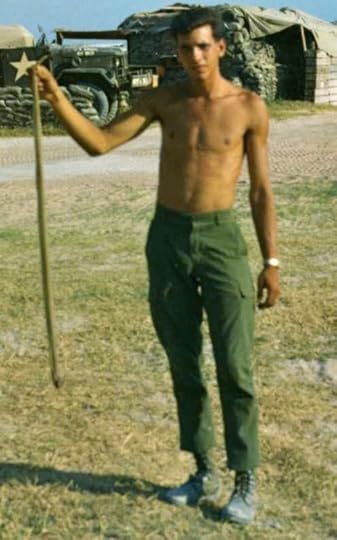
Staff Sergeant Scavio making a new friend
The Wrestling Match
The other NCOs in the battery did not like me because my radar section did not do anything to support the battery, like pulling guard duty shifts at night. Supposedly our job was already 24 hours a day. Plus I looked like I was 12 years old, and here I was a staff sergeant. They were constantly doing shit to me. They didn’t realize I was the youngest of four brothers and wasn’t going to take anything from them.
During mortar attacks the radar crews had specific duties. Only a couple of operators stayed in the radar bunker and everybody else took up positions in the small fighting bunkers on the berm (the earth mound surrounding the firebase). On top of one of our radar bunkers we built another observation bunker so we could get up and look for mortar splashes so we could run out and get a back azimuth for a target. If I was not up there I would be checking my guys in the fighting bunkers, which always made for comic relief because they’d be hiding as close to the ground as they could get afraid to put their heads up. I literally had to kick some ass, “You’re supposed to be watching!”
But I’m no hero. I had not been there very long and was relieving a young buck sergeant who was leaving. He was a good kid. He and I were up in the observation bunker during a mortar attack looking to see if we could find some splashes. All of a sudden a mortar lands really near by us. He and I got into a wrestling match to see who could get under the other guy. It was like, holy shit, they’re wired in on us. He didn’t want to get killed, and I didn’t want to get killed. It was an all out struggle to get to the bottom of the bunker and leave the other guy on top. We laughed about it later about how crazy we were because probably both of us would have been killed anyway.
From Jubilation to Panic
It was early in the morning and somebody spotted half a dozen NVA regulars in uniform straight out from the Quad-50 machine guns behind the radar section. There was a tree line out there, just outside small arms range and also in some sort of no-fire area. They were just watching us. They knew that we knew that they are there, and that we had no permission to fire.
Every night one of the Dusters would crank up its engines, you could almost set your watch by it, and take a ride around the inner berm, just outside the first set of wire. He would take a run around, warm his engines and make sure his track was working. Well on this occasion he comes around, and just as he gets past the Quad-50 he turns his turret and starts walking rounds toward this group of NVA. Of course they pick up and start running. Unbeknownst to us this was part of a clandestine operation. The Armored Cav had circled around the back of them in armored track vehicles with 50 caliber machine guns. Whoever orchestrated this thing planned to push the NVA into these guys. As this started happening, a bunch of our guys jumped on the berm and started cheering.
Now the NVA are between us and the Armored Cav. The next thing you know the Cav open up with their 50 calibers. With a range of 2,000 yards the 50 caliber rounds start coming onto the firebase. When everybody realizes what was happening all the cheering stops. They’re diving for cover, screaming and yelling. In a second it went from jubilation to panic.
Oops
Every night the major from S2 Intelligence would call down from battalion and tell us to aim our radar this way or that way. The radar unit had a very narrow band so that you had to be looking right at something to pick it up. The exercise didn’t make any sense and we hardly ever picked up anything.
We took a beating one night with casualties. The next day of course the world is all over you. I am in our bunker that holds the big map where we plot mortar locations. It’s in the morning and it’s ungodly hot, 100 degrees by eight o’clock. If you moved at all you sweat like a pig. I have my back to the door looking at the map, no shirt on, when someone comes in and says, “How come you guys didn’t pick up any targets last night?”
Without looking around I say, “It’s because of the horseshit intelligence we get around here. They tell us to look one direction, and of course the mortars come from another direction. So what do you want?” I turn around to see the S2 major. I didn’t worry about it because these guys from battalion would show up, chew you out for a little bit, and then they’d be gone and you’d probably never see them again.
A Little Privacy Please
From the time I got into the Army I was not one of these guys who could go into the latrine and sit with half a dozen guys and take a dump. It was not in my DNA. During all my training at Ft. Sill – Basic, AIT and ACL – my favorite thing was fire guard duty at night.
Many of the training barracks at Ft. Sill were drafty WWII clapboard structures originally intended as temporary barracks. By any standard they were enormous tinderboxes. Trainees rotated one hour shifts during the night, with buckets of sand lining the walls in case of a fire.
I liked fire guard at night because I could get to the latrine with nobody around and take a poop. Before Sherry when I was out in the field up north I could always find a tree somewhere. At Sherry I’d wait till two or three in the morning, find the latrine which was close to our radar bunkers, and get nice and comfortable. Soon as I settled in, sure as shit something would happen. I can’t tell you the number of times I got caught in that latrine during a mortar attack. That latrine was not much protection, just plywood walls and a corrugated tin roof. You did not want to be in there with mortars falling.
April 22, 2015
Jim Scavio – Radar Section Chief – Part One
The Road to Vietnam
My oldest brother had already been in and out of the service. The next oldest did not go in because he had bad feet. My next oldest brother joined the Air Force out of high school. However I was going nowhere fast, a poor kid from an Italian neighborhood. Rather than wait for the draft I went down one day and said, “Take me.” Sitting around waiting to get drafted was worse than not knowing. I was just 18 years old and never told my folks that I had volunteered for the draft.
I went to Ft. Lewis, Washington for basic training. I took the test for OCS (Officer Candidate School) and somehow passed. They gave you a choice of one of the four combat arms: Artillery, Armor, Engineering and Infantry. I talked to the other guys in my company who had passed the test, and of course not knowing anything about it we figured the Artillery was the place to be because these guys are way back here and the enemy is way over there, a WWII type of thing in our limited knowledge. The Engineers sounded way too much like work; the Infantry was not even in the conversation; Armor I could have gone either way; but Artillery sounded like the safest place to be because you weren’t in the front lines.
Out of basic I was promoted to Private First Class for no reason (The top third of basic training classes were automatically promoted to E-2, giving them a single stripe on their sleeves). From there I went down to Ft. Sill, Oklahoma into Advanced Individual Training, which was just basic fire direction control for guys going to OCS. Did you know that fire direction control at the time was the hardest specialty in the Army? In this class we had a bunch of college graduate types, all draftees with bad attitudes. I was one of the youngest.
Our classes are in the same building with the OCS guys and we’re watching them running around. And then the rumors start. A – if you go to OCS you have to spend another year in the Army. B – if you came out a second lieutenant you would become a forward observer in Vietnam and you wouldn’t live 30 minutes after you arrived. Then C – if you flunked out you were going to be a gun bunny, humping ammo the whole time. We’re sitting around strategizing and thinking maybe this OCS thing is not what we want.
They had just started the ACL program (Artillery Combat Leadership – intensive training to prepared non-commissioned officers for Vietnam). There had only been one class, and they were recruiting people for class number two. They came around with this alternative to all of us who were going to drop out of OCS, which was virtually the whole class of 50 guys. The only rule for getting into the program was we had to volunteer for Vietnam.
It was good training, they really did a good job, and that’s what kept me from turning into a banana case. I personally did not think I could make it through OCS anyway. I had an inferiority complex around guys four and five years older than me and with college degrees. I was worried about the academics. So this seemed like the right avenue for me. I made it through ACL about in the middle of the class. And there were bright guys in there, from Stanford and all over the place.
After graduation everybody got a short OJT assignment (on the job training). Mine was to teach the manual method of crater analysis to officer candidates and other upcoming ACL classes. You had to be able to look at a mortar impact site, do a best guess of angles and quadrants, and then do the math in your head to estimate where the mortar came from. When the artillery fires back the rounds cover a pretty wide area, so speed is more important than pinpoint accuracy.
A Radar Guy … But Not Really
When I got to Vietnam I was assigned to the 8/26 Artillery and I figured I would go into FDC (fire direction control). When I got there they said, We don’t have any guns here. We’re a target acquisition battalion, counter-mortar radar.
I didn’t want to be there, I didn’t know anything about radar, I can’t do this, it’s not me. I begged them to get me out. I said, “I’m not kidding, I can’t help you guys.”
They said I could. They wanted me to teach the same manual crater analysis from my OJT to radar crews because they came to Vietnam with none of that, and to new forward observers who probably slept through that part of their OCS class thinking they’d never use it. I wasn’t training anybody on how to operate radar equipment because I couldn’t even spell it. Back then there was a lot of Vietnamization going on (transferring operations and skills to the South Vietnamese Army), so I would try to teach them too, which was really hard because of the whole communication gap, and then trying to teach them trigonometry. We were never effective with the South Vietnamese, but we tried.
The radar units were down more often than they were up. And they had such a narrow bandwidth close in that you had to be looking right at the mortar to get a target. We seldom got a target during a mortar attack. Instead we would go out after an attack and do crater analysis and figure backward to where the mortar came from. We’d give a detailed target to FDC and say we’re pretty sure if an attack comes from this direction it’s going to be from right here. So that was the idea, to establish these likely locations. In a jungle area there are not many places you can launch a mortar from, because of overhanging branches. Frankly I enjoyed the hell out of that. I probably would have committed suicide if I had to sit in front of one of those radar screens for any length of time. It just wasn’t me.
Dak To
I had orders to travel to radar units throughout our area of operation. The worst place was Dak To (300 miles north of LZ Sherry near the border with Cambodia and Laos, where the three countries touch). Dak To and a Special Forces camp closer to the border were charged with interrupting traffic on a spur of the Ho Chi Minh trail that ran down through Laos and Cambodia, crossed into Vietnam at Dak To, and from there ran south. A few months before I arrived in Vietnam the NVA (North Vietnamese Army – seasoned regular troops) began building a huge force in the area (four battalions of infantry and artillery). Dak To and the Special Forces camp just down the road were their targets.
The 4th Infantry Division had just pulled out of Dak To, to be replaced by South Vietnamese forces, again a part of Vietnamization. The South Vietnamese never shown up, leaving just a battalion of engineers, an artillery battery and an old radar unit. The engineer lieutenant colonel who commanded Dak To knew he was on his own and saw what was coming. He pulled his guys in from surrounding areas, reduced the size of the compound and fortified the perimeter with fighting bunkers and machine gun emplacements.
The NVA attacked in May of 1969 with a barrage of mortars, rockets, recoilless rifles and artillery. The defenders of Dak To held on – 600 engineers, artillerymen and a handful of radar guys up against 5,000 NVA regulars. For three months the NVA laid siege with daily attacks and nightly sapper probes of the wire. Only once did the enemy get inside the compound. When it was over three months later the men of Dak To had suffered a 45% casualty rate. It was only then that visiting senior commanders learned the South Vietnamese had never showed up.
I went to Dak To during the siege to get counter-mortar targets for them, traveling between our main radar unit at Dak To and the Special Forces camp scared as shit. It was a nightmare. In one 24 hour period we took 120 rockets, mortars and artillery. Some of the artillery they hit us with were big guns from across the border. The good news is I was only there for three weeks. The NVA suddenly quit and just went away. After the threat was gone I went on to other places.
Camp Radcliff
Camp Radcliff was a big, sprawling place. It held a large number of attack helicopters that supported the whole region and was also my battalion headquarters. The radar unit was on top of Hong Kong Mountain right beside the camp. The mountain was covered with double and triple canopy jungle, and there was nobody up there but us so we had to guard our own perimeter. Talk about scary. We would hire kids to cut back the foliage as far as we could to give us a line of sight. If you didn’t clear the jungle out the NVA could just walk right up on you. That was our greatest fear. Radar guys had absolutely no training in fighting and did not want to be in combat. Most of these guys had enlisted for air traffic controller.
We were looking down on the camp when sappers got through its wire and set a fuel dump on fire.
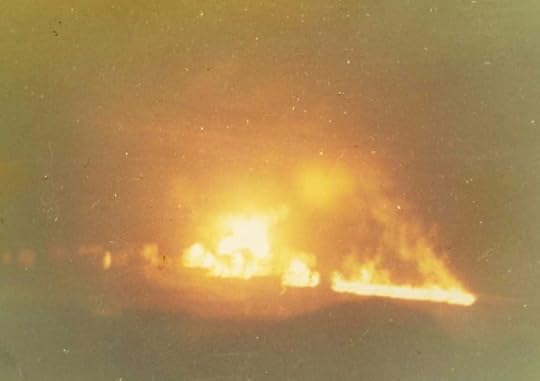
Sapper attack on Camp Radcliff
Helicopter gunships took to the air in pursuit of the sappers. They made their runs over the top of Hong Kong Mountain, so low we could almost touch their skids. They swooped down the side of the mountain, leveled off toward the camp perimeter, and fired their rockets. It was very cool to watch.
A Reluctant Promotion
After six months of moving around to a dozen locations they put me in for a promotion and somehow or other I came in number two on the test. They promoted me to staff sergeant E-6, but took me out of my primary specialty of artillery FDC and made me radar. I was at first opposed because I wanted to stay in the artillery. They said I could always go back to artillery later on, so I agreed to it. That’s when they said they were sending me to LZ Sherry.
Sherry had the worst reputation in the battalion – word got around you know – because its entire radar crew got wiped out in one attack. It was in the spring or summer of 1969 during a highly unusual daytime attack. Most attacks came in the middle of the night so during the day you were out and about. That day the radar guys were outside doing something together when a mortar round caught all of them. They all got shrapnel wounds bad enough to get medevac’d out. They all did come back. Other places were probably worse – they were all bad, you could interchange these places like a sweater – but Sherry was the only place where everybody got it all at once, something like five or six guys.
Another thing about Sherry, if we had a real malcontent up north he ended up down there. I had one guy up on Hong Kong Mountain I thought I was going to have to shoot one night. I had assigned him to a standard three hour guard duty shift at night. He came in one night and said to me, “I’ll be the one to decide if I do what you tell me to do.” He was that way not only to me but to a lot of people. You can’t have that when you’re at a place like Hong Kong Mountain and afraid to go to sleep. We ended up sending him to Sherry and he’s one of the guys wounded and I heard he maybe lost his legs in that attack.
When they said they were sending me to LZ Sherry I figured I did something wrong. I said,
“Take my stripes and leave me here.” The Army doesn’t work that way I found out. With the promotion they wanted me on a different assignment and the one they chose was at LZ Sherry. I never did get a decent explanation. They said as an E-5 you’re still one of the guys, but as an E-6 staff sergeant you are beyond that and can’t be one of the guys anymore, which meant I had to have a change of venue. I suspected the real reason was that I was not supposed to get the promotion. I think they threw me into the promotion pool because they needed to have a certain number of people apply. The top two of us on the test were so far ahead of the other candidates they didn’t have much choice. You were supposed to have six years time in grade before making E-6 and I had just over six months, plus I was barely twenty years old. They said the other guys would not respect me.
My new job was section chief of the counter-mortar radar unit at Sherry. Once again I am in charge of something I don’t know anything about, only now at the worse firebase in the battalion. Sherry really did have this horrendous reputation. Dak To was bad too, but at least it calmed down. Sherry never calmed down. “You’ll be fine,” they said.
April 15, 2015
Jim Blaydes – Gun Crew – Part Two
LZ Sherry
When I was infused out of Firebase Tomahawk they put me on a chopper and sent me to Phan Thiet. I had never heard of the 5th battalion or the 27th artillery or LZ Sherry. I took my time and spent a couple days on the beach. When I finally got to LZ Sherry it was supper time. I ate and then they gave me a hooch and as soon as it got dark, my first night there … poomph … poomph … poomph … the mortars started coming in, and this happened two or three times a week. I was not used to this at all. At Tomahawk the gooks pretty much left us alone, except for that one night.
I had been a gunner on the 155 howitzer for eight months, setting the direction and quadrants, so the sergeant put me on Gun 1, which was named Bullwinkle just like my gun at Tomahawk, and made me a gunner again looking through the scope and setting the direction of the howitzer.
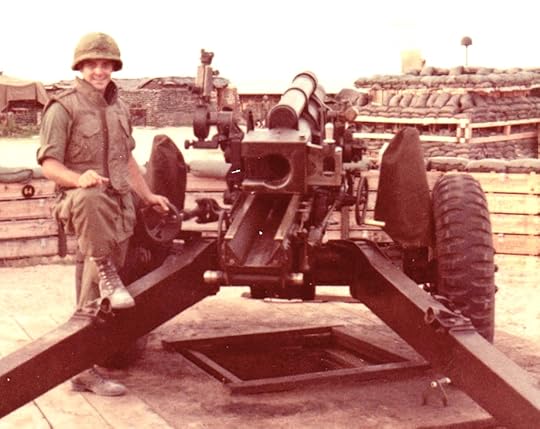
Blaydes and Bullwinkle
I am at Sherry just two weeks on a guard shift. Me and this 18 year old kid are sitting out in front of the powder bunker and it’s around one o’clock in the morning. He had got married right before he shipped out for Vietnam. He showed me a picture of his wife and everything. He’d been there six months or so and he says, “I’m going on R&R in a day or so to meet my wife in Hawaii. There’s no way they’re going to get me tonight.” Well the mortars stared coming in, six or eight, and one hit twenty feet in front of us on the sandbag wall. It got him pretty bad in the leg, mangled it good. Shrapnel hit me in the back, but my flak vest took most of it, putting small pieces of shrapnel along my right arm. That flak jacket probably saved my life.
More mortars hit, this time three or four inside the gun pit. I am laying on the ground, there’s dust everywhere, and I hear this damn hissing. I thought the powder was on fire. In basic training they teach you how to low crawl. Well I low flew about 50 yards out to another gun pit. Then I come back and saw that both tires were flat. Flat tires don’t mean the gun won’t shoot, so we turned the howitzer around and fired it toward where the mortars were coming from.
A couple weeks later they called a special formation. They called me and four or five other guys up there and presented us with Purple Hearts, pinned them on our shirts.
After that night I thought, Man this is not a good place to be standing out fooling with a scope. I was used to being inside my 155 howitzer track, not out in the open with mortars coming down. And that gun was not sandbagged right. Every time it fired it would slide around in the sand, but we just kept shooting. I told the buck sergeant, We need to re-lay this gun. He said, We never done that before. I said, I’ll tell you what, you get somebody else because I don’t want to be killing people, there’s too much discrepancy. It might not be much, but it was way more than I was used to.
I refused to shoot a gun I thought was dangerous and instead became a powder monkey; I humped ammo, set fuses and cut powder charges. When we got mortared I went on the M-60 machine gun out on the wire (in a small perimeter fighting bunker). That’s where I was on August 12.
Two mortar attacks on August 12 kill Theodus Stanley and Howie Pyle and wound seven others.
UFOs
For a period of about two weeks, the last part of July, we saw a UFO every night. It appeared back toward the coastline about a quarter mile from us at an elevation of about 500 feet. It came on just like a light bulb in the sky, made no noise whatsoever. It set motionless, or moved just a little bit. Might stay on a minute or two, might stay on half an hour or so. When it got ready to leave it shot across the sky usually east, again making no noise whatsoever.
When we first saw it the first couple of nights we couldn’t wait to see it again. After a week or so we didn’t pay any attention to it. A lot of guys on the gun crews saw it. You might think I’m crazy, but I did not smoke marijuana, I did not take drugs, and I drank very little beer. It turned into entertainment. We didn’t think much of it because in our situation we were thinking of blood and guts. It was the same sort of lights you see on TV programs about UFOs. The thing is when they move they move way faster than any aircraft and they don’t make any propulsion sounds. They went from directly south to directly west in an instant.
Similar sightings were common in Vietnam, often referred to as “enemy helicopters,” even though the enemy had no helicopters during this period and no aircraft could move with such speed and agility. In perhaps the most notorious incident in June of 1968 Air Force Phantom jets pursued a cluster of lights believed to be enemy helicopters near the DMZ. As the lights moved out to sea with the Phantoms in hot pursuit things began to go wrong. The Phantom radar systems activated a cut off mechanism to prevent large objects from flooding the radar scope, which made it impossible for the pilots to distinguish a ship from a slow moving object. Believing they were engaging the enemy the Phantoms fired air to surface missiles at a US swift boat killing five of the seven crew members, and later attacked the Australian warship HOBART killing two and wounding seven. Three other friendly vessels came under attack but without casualties. The pilots involved in the operation, classified as friendly fire, were relieved of duty and grounded. The next night the lights returned, still with no explanation, and continued to appear on multiple nights. US command ordered the Air Force and artillery not to fire on the lights, fearing a repeat of the attacks on friendly forces. No wreckage of enemy aircraft was ever found.
No one doubts the existence of mysterious lights in the sky, viewed by thousands of ground soldiers in multiple locations and described in similar terms. And no credible explanation for them has ever been put forward.
When You Turn Into A Real Soldier
After the August 12 attacks I was waiting for my early-out orders to go home and go back to college. I was a real short timer and so darn scared I didn’t want to be in the open. On guard rotation in the middle of the night I’m sitting there wanting a cup of coffee, and afraid to walk to the pot 30 paces away.
But our Chief of Smoke, a Hispanic guy (Sgt. Cerda), with the mortars falling everywhere would walk straight down the middle of that the battery with his chest stuck out cussing you to get out on your gun. I mean that sucker had no fear of dying. I was amazed at him. I learned something from him: if it’s gonna get you it’s gonna get you. When the mortars are falling you hit the ground, but when a break comes you get up on the gun, load the gun, shoot the gun. I guess when you figure you’re probably gonna die you turn into a real soldier.
Saved By A Bad Tooth
Hank Parker sent me back to Phan Thiet to get a tooth fixed. After they fix my tooth I hung around for as long as I could, around two days, because I do not want to go back. I am laying on my bunk, it’s about two o’clock in the afternoon and this little Specialist 4 walks in and says, “Your name Blaydes?” I say, Yea. He says, “You’re out of the Army. I’ve had your early out orders here for two weeks.”
I ‘bout choked that SOB right there.
He says, “You get any medals?”
“I got a Purple Heart.”
“How’d you get it?”
“I took some shrapnel in my arm, the doc pulled ‘em out, and they gave it to me.”
He says, “Oh, I’m not going to worry about that. Get on the chopper back to Sherry, get your stuff and I’ll process you out tomorrow.”
There is nothing in my footlocker at Sherry I want. I had in there my Purple Heart, a case knife, some money and other stuff. I don’t care, I just want out. I say, “No, you get your pencil right now,” and we go to his office and process me out right then and there. He has my DD 214 (discharge papers) all screwed up, none of my medals are on there. I fly to Cam Ranh Bay and the next morning I am on a plane to Ft. Lewis, Washington.
I’m home back in Kentucky almost a year after a semester of college, and here comes that footlocker from Vietnam. My money and case knife are gone. My Purple Heart is still in it, but no award documentation, and it’s not listed on my DD 214. So officially in the eyes of the Army I don’t have a Purple Heart. I guess I could have stayed around in Vietnam to get my paperwork straightened out, but at the time all I wanted was out, nothing else mattered.
I wouldn’t want to go back to it again, but I wouldn’t take anything for the memories.
April 8, 2015
Jim Blaydes – Gun Crew – Part One
The Boys of Bardstown, Kentucky
Jim began his military career with an artillery battalion of the Kentucky National Guard. Its individual batteries were made up largely of boys from a single community. They enlisted with school friends and often sibling brothers under the promise they’d stay together as a unit. Jim joined B Battery out of Elizabethtown, while a young man who would become Jim’s best friend signed up with C Battery in Bardstown.
Charlie Battery is a good example of the chunk of young men the National Guard could take from a small community. Of its 117 recruits, 105 were from Bardstown, a community of less than 6,000.
When the battalion activated for Vietnam both Bravo and Charlie Batteries found themselves together on a mountain at Firebase Tomahawk southeast of Hue. Charlie Battery occupied a plateau just below the forested top of the mountain, while 22 infantrymen of the 101st Airborne Division, standing down from fighting in the much contested Ashau Valley and looking forward to the amenities of a firebase, guarded the perimeter facing up toward the forest. Jim’s Bravo Battery encamped further down the hill.
This was North Vietnamese Army country, and the Kentucky boys were giving the NVA fits. From FB Tomahawk the two batteries had a commanding view of the surrounding country, and with their twelve 155 mm howitzers could reach targets eleven miles away.
The NVA prepared its attack on Charlie Battery for several months, even constructing a mock firebase for practice attacks. They struck in the early morning hours on June 20, 1969 during monsoon season. The NVA massed 150 sappers in the woods above Charlie Battery, and at 1:45 AM in the pouring rain 75 of them, clad only in loin cloths and skull caps, and loaded with satchel charges and RPGs (shoulder rockets), began slithering through the concertina wire. When they were well into the wire their comrades opened up a mortar attack. The sappers overran the 101st infantry perimeter guard, killing four and wounding 13 of them on their way into the compound followed by the rest of their force. They dropped satchel charge down the howitzer tubes and into bunkers; they fired RPGs and AK-47 rounds everywhere
Cobra gunships and other air support took an hour getting to Tomahawk due to weather. Jim’s Bravo Battery lobbed illumination rounds over Charlie while the remainder of the 101st fought hand-to-hand and in close quarters. Eventually the Cobra gunships and Spooky’s fearful Gatling guns arrived and forced the enemy to retreat, leaving behind 27 dead and one POW. The attack lasted two hours and almost entirely destroyed the compound: buildings, ammo storage, bunkers, trucks and howitzers.

The morning after at Tomahawk
Charlie Battery lost ten dead and forty-five wounded. Five of the dead and most of the wounded were Bardstown boys; two more died of their wounds within the month. The attack took an eighth Bardstown resident when the mother of two boys injured in the attack killed herself with a shotgun upon hearing the news.
Vietnam took a total of 17 young men from Bardstown, giving it the highest casualty rate of any community in the U.S.
The attack on FB Tomahawk occurred when the original crop of Kentucky boys were near the end of their tour. An Infusion Program was underway to gradually rotate green troops in while sending seasoned troops to other artillery units in order to smooth the transition. Following the losses on June 20 the Army accelerated the process in order to avoid further heavy losses to a single community. A month and a half later just a quarter of the original battalion remained.
* The account of the attack on Firebase Tomahawk relies heavily on KENTUCKY THUNDER IN VIETNAM: History of the 2nd Battalion, 138th Field Artillery in the Vietnam War 1968 – 1969 by John M. Trowbridge, and to a smaller degree on THE SONS OF BARDSTOWN by Jim Wilson.
In His Own Words

Jim Blaydes – on his first day in Vietnam
When the battalion was activated for Vietnam there was a lot of brothers in the unit. They had the option of one brother going and one staying, but they all said, If my brother’s going I’m going too. There was about ten or twelve of them.
We had 155 mm self-propelled howitzers with 50 caliber machine guns mounted on the turret. I was on Gun 6 and we had her named Bullwinkle.

Jim in his 50 caliber machine gun turret
In background another 155 self propelled howitzer
The 155 mm self-propelled howitzer had a crew of six men. They fired the weapon from inside the vehicle.
For the first few months in Vietnam my battery moved around to different firebases around Hue. Then we settle down at a barren bump called Tomahawk Hill supporting the 101st Airborne Infantry and shooting about 200 rounds a night. We didn’t get mortared every night like down at LZ Sherry, I think because we had the 101st Airborne on our perimeter.
The 155 mm howitzer shell weighted almost 100 pounds, so heavy you needed a mechanical ramrod to lift and set them into the breach. Well there was a little guy on my gun about five nine, weighted 190 pounds, he was just a stump and had really big arms. Instead of using the mechanical ramrod this guy would curl a round in his left arm and take the palm of his hand and seat that sucker with his bare hands … I still remember the sound … shuck. We’d stick the powder in there, slam the breech and shoot. We were shooting six rounds a minute, twice the usual rate and so fast the barrel would heat up and start to cook off rounds (fire when the breech closed) and we’d have to quit, let it cool down awhile. Nobody else in my battery could do that. Some of the forward observers, if they were pinned down, were calling for SIX ROUNDS HE (high explosive) GUN 6. They’d call back with body counts and December of 1968 Gun 6 got 35 confirmed kills by itself.
Firebase Tomahawk sat on a mountain top right on the China Sea. C Battery was on a plateau on the side of the mountain because the top of the mountain was wooded. My B Battery was stationed at the base of Tomahawk. Still it was elevated ground and from up there we could shoot maybe ten or twelve miles.
The North Vietnamese came over the top of the mountain through those woods. The 101st when they came in from patrol had put defensive posts up there along with concertina wire. Well they thought they were on R&R at the firebase, drinking beer and not paying attention. The sappers killed or wounded just about everybody before they even got to the firebase. There were three or four gooks sitting above the firebase shooting RPGs into the howitzers, like ducks in a pond.
We shot illumination rounds up above the attack from 1 o’clock in the morning when they came in, to about 3:00. They were in the perimeter for two hours. They blowed up four of the six howitzers, put satchel charges down the barrel. One they pulled the door shut with everyone inside and fired an RPG into it, and everyone inside got fried.
They next morning I got sent up to get the howitzers that would still run, there were just two. The ground was still smoking and the bodies of NVA dead were piled on the ground, close to thirty of them, and that didn’t count the ones they carried off. The NVA had destroyed everything but the FDC bunker (Fire Direction Control): all of the five ton trucks, all of the deuce and a halves, all of the quarter tons, all of the jeeps, all of the equipment on the mountain. No telling how many satchel charges they had (reports estimate the number of satchel charge explosions at 150). It was a mess.
My best friend in basic training was killed that night up there with Charlie Battery. Ronald Simpson was a high school football star, weighted about 210 and not an ounce of fat on him. He jumps up on that 50 caliber machine gun on top of the howitzer track and starts blowing those fuckers out of the wire. He was a big target and got killed by an RPG. They told me Ron held them off for about ten minutes. He was a tough guy.
There were ten guys killed that night, five of them from Bardstown, Kentucky. That was about the time my nightmares started.
Let me tell you something about Charlie Battery. The other batteries were envious of them because they were sitting up there overlooking the beach and the South China Sea. They had housekeepers and maids taking care of their hooches and washing their cloths. They had not been hit in six months, no mortars no nothing and living the life of Riley. They had not been out in the boonies moving around to all them firebases like the rest of us had – A and B Batteries. Their security was not that good and when the attack first hit I don’t think they even knew where their weapons were. Others might have a different story, but that’s just my opinion.
Eyewitness accounts from 101st Infantry participants confirm that the artillerymen of Charlie Battery were ill prepared to defend themselves. Most died and were wounded inside their bunkers or trapped in their tracked vehicles.
After that the brass were worried about having so many guys from a little town in one battery and began infusing us into different units. I was one of the last to get infused, which is how I ended up at LZ Sherry.

